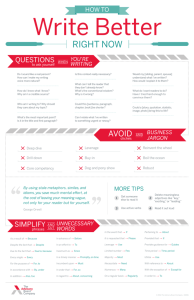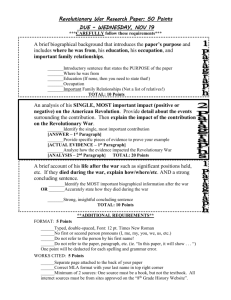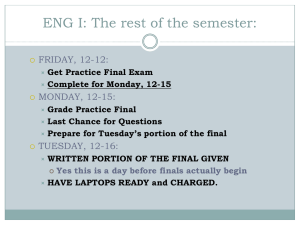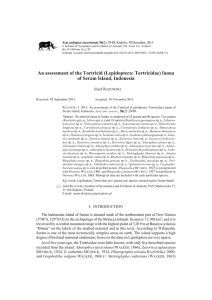lecture slides
advertisement
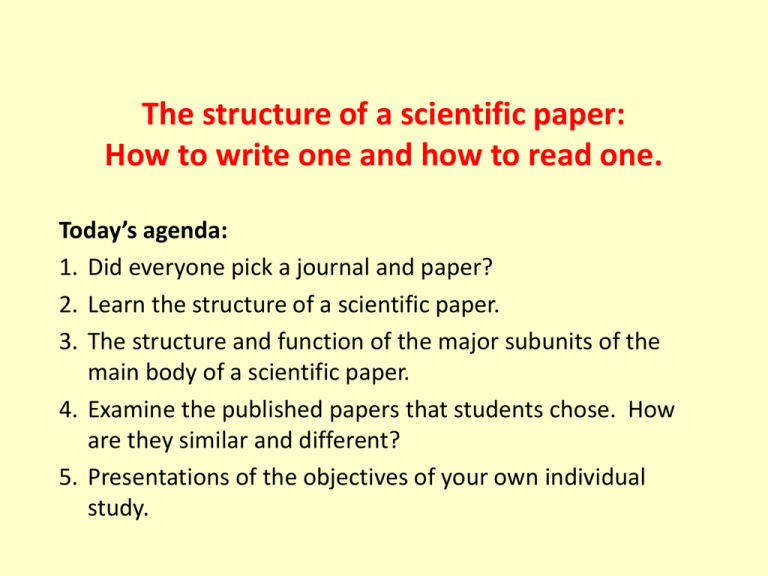
The structure of a scientific paper: How to write one and how to read one. Today’s agenda: 1. Did everyone pick a journal and paper? 2. Learn the structure of a scientific paper. 3. The structure and function of the major subunits of the main body of a scientific paper. 4. Examine the published papers that students chose. How are they similar and different? 5. Presentations of the objectives of your own individual study. A scientific paper is really three (3) separate papers. This fact is critically important when you set out to write a paper, or to read one. Although, in published form, the title comes first and the abstract second, they are nearly always the last to be written Title: Fishing for readers Abstract: The “Reader’s Digest” version The body of the paper: The whole story What to write first? Although, in published form, the Title comes first and the Abstract second, they are nearly always the last to be written, or at least the last items to be finalized. The body of the paper is tackled first. The body of a paper in a typical journal: • Introduction • Materials and Methods (sometimes just “Methods”) • Results – Text – Tables – Figures • Discussion • Acknowledgments • Literature Cited A number of journals, including some highly prestigious ones like Science and Nature, have very different formats, but we’ll focus on the standard format used by the vast majority of journals. The Introduction Begin with the broadest scope and get progressively narrower, leading steadily to the statement of objectives in the last sentence or paragraph of the Introduction. Statement of objectives: The key to the whole paper The last sentence or last paragraph of the introduction needs to flow from the rest of the introduction and transition to the description of the materials and methods. It is critical that the goals and objectives be stated clearly and, if applicable, stated quantitatively. An example of “Objectives”: Not so good: The purpose of this study is to see if there is a difference in the fish in three parts of the stream. Much better: The overall goal of the study was to test the hypothesis that habitat complexity was positively correlated with fish species diversity and density. Specifically, we sampled the fish community and physical features in two habitat units in each of three reaches of stream and also measured the microhabitat features where fish were caught. These data were used to. . . . Materials and Methods (or just Methods) Description of what was needed to do the work (e.g., specimens), what was done, and how it was done, when and where (if these are necessary details). Not a narrative, as you might write to your friend describing your day (“First we drove the van to the river, then we launched the boat and. . . .”) but rather a concise description of what a reader would need to envision, understand, assess, and (if needed) replicate the work. An example of “Methods and Materials”: Standard length (SL) is used throughout. Terminology and methods for taking counts and measurements follow Pietsch and Grobecker (1987). The holotype is deposited in the collections of the National Museum of Natural and Cultural History, Jakarta, Indonesia (NCIP). Symbolic codes for additional institutions are those provided by Leviton et al. (1985). Whole genomic DNA was extracted from skeletal muscle of the holotype of the new species and three specimens of Histiophryne cryptacanthus (tissues unavailable for H. bougainvilli) using the QIAamp DNA Mini Kit (Qiagen). Three outgroup taxa were chosen. . . . The Results 1. Verbal description of the findings of the study as they pertain to the hypotheses and goals, in the order in which the hypotheses were posed. 2. Figures (as needed). 3. Tables (as needed). 4. Statistical analysis (as needed). 5. No interpretation, no comparison, just the facts, with no editorializing. The Discussion Begin with the interpretation of the data, with respect to the specific objectives of the study, and then get progressively broader, interpreting papers by others, ending with the concepts used to start the Introduction. Acknowledgments 1. Common professional courtesy (distinct from authorship, although this can be contentious). 2. Indicate source(s) of financial support. 3. People who contributed with help in the field and/or lab, with ideas, statistic analysis, etc., (those whose contributions were less than those expected for co-authorship. 4. Only professional, not emotional help (find other ways to thank your mother or your boyfriend). Literature Cited (or References Cited) 1. Acknowledges the work done by others. 2. Allows the reader to learn more. 3. Bolsters arguments and facilitates interpretation of results. Everything cited in the paper must be listed, and nothing else. This is not a bibliography but strictly a list of relevant papers on the subject, only the ones actually used in the paper. They must be listed in alphabetical order, in the format specified by the selected journal. Most of us never read a paper from start to finish: Read the title first, then the abstract, then the last paragraph of the Introduction, then the first paragraph of the Discussion, look at the figures and tables. Class activity: Let’s look at your chosen papers. Tell us a little about why you chose them and what they are about. Let’s see how they are organized and how best to go about reading them. Let’s hear about your own projects: Give us a short, ten-minute summary of what you intend to do. In such situations you must assume that the audience is interested but not informed. Thus, the introductory sentences are most critical. Assignment for Monday: Read your chosen published paper again, from the perspective of what you have learned. Next time, be prepared to tell the class, in greater detail, what it is all about. Paradoxically, it is harder to say something in such a short period of time than it is to speak for a longer time. So, practice ahead of time!

